Amazing Partial Solar Eclipse Photos by Skywatchers (Oct. 23, 2014)
The moon passed between the Earth and the sun on Thursday, Oct. 23, creating a partial solar eclipse that could potentially be seen by millions of stargazers across most of North America, weather permitting. For a recap, read our full story: Partial Solar Eclipse Wows Skywatchers Across North America (Photos). See photos and video (above) of the partial solar eclipse from skywatchers and professional astronomers who streamed live views of the event online, in this Space.com gallery:
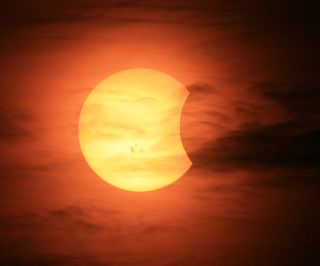
Skywatcher Brad Whitsitt of Indianapolis, Indiana captured this view of the Oct. 23 partial solar eclipse seen through wispy clouds at 6:15 p.m. ET using a Canon 5D camera and 700mm lens equipped with - most importantly - a protective solar filter. A giant sunspot group can clearly be seen on the surface of the sun. Credit: Brad Whitsitt.

Photographer Sean Parker created this mosaic of the partial solar eclipse by snapping photos of the event every 25 minutes on Oct. 23. He took the photosfrom Tucson, Arizona, using a Canon t3i camera with a 70-200 F/4 lens, Canon 2x Extender and a solar filter. "The spots you see are actually large sunspots," Parker wrote in an email. Credit: Sean Parker.
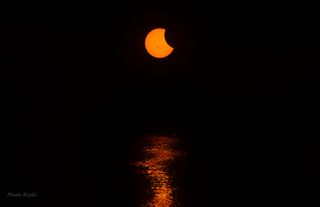
Skywatcher Mark Ezell watched the Oct. 23 solar eclipse from Austin, Texas, where he captured amazing views of the event as it occured over Lady Bird Lake near the city's downtown area. "This was my first time photographing a solar eclipse and I was thrilled to capture the sunspots as well," Ezell told Space.com in an email. Ezell used a homemade Baader film filter and a 200mm lens to capture this view. Credit: Mark Ezell.
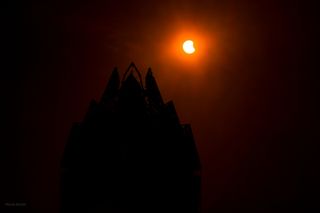
In this photo, also by skywatcher Mark Ezell, the partial solar eclipse is seen with the silhouette of a building top in Austin, Texas, where Ezell was observing from. Credit: Mark Ezell.
Get the Space.com Newsletter
Breaking space news, the latest updates on rocket launches, skywatching events and more!
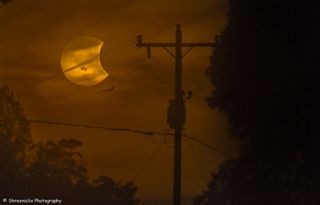
Photographer Shreenivasan Manievannan in South Carolina captured this view of the partial solar eclipse of Oct. 23, 2014 through fog and power lines, revealing an ethereal view of the event and giant sunspots on the sun. "Unfortunately clouded out, got these shots of the eclipse with a layer of fog over the sun. Hope you like them," Manievannan wrote in an email. He used a 300mm lens on a 1.5x crop sensor with layers of ND, UV and polarizer filters. Credit: Shreenivasan Manievannan.
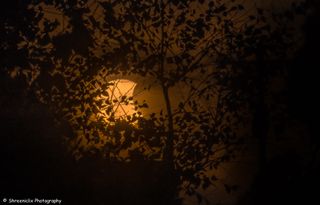
Despite the fog and clouds, Mannievannan managed to capture some stunning views of the partial solar eclipse. Here, the eclipse is visible through the leaves and branches of a tree in a truly stunning combination of space and nature. Credit: Shreenivasan Manievannan.
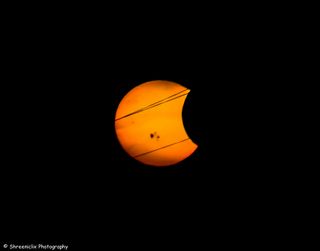
This close-up of the partial solar eclipse was also captured by Manievannan from South Carolina before thick clouds rolled in to obscure the view. Credit: Shreenivasan Manievannan.
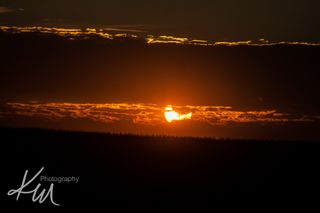
Photographer Kali Morgan sent in a photo of the partial solar eclipse taken in Rantoul, Illinois, on Oct. 23, 2014.
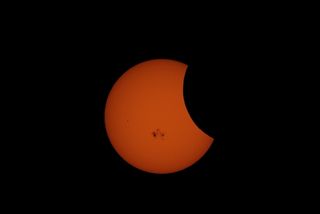
Astrophotographer Bob Hatfield caught the partial solar eclipse in Southlake, Texas, on Oct. 23, 2014.
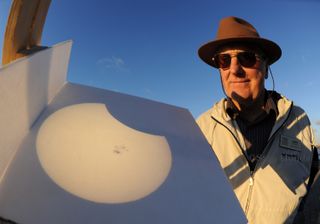
A projected image shows the partial solar eclipse as seen in Cleveland, Ohio, on Oct. 23, 2014. Gary E. Kader, Director of Burrell Observatory at Baldwin Wallace University in Berea, Ohio, stands with his 5-inch Alvan Clark refractor telescope (built in 1874). Photo by Stan Honda.
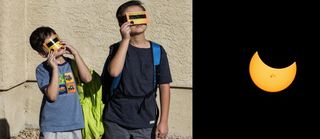
Astrophotographer Tyler Leavitt sent in a composite image of kids viewing the partial solar eclipse in Las Vegas, Nevada, on Oct. 23, 2014.
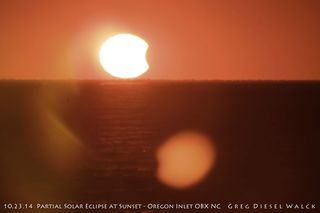
Astrophotographer Greg Diesel Walck sent in a photo of the partial solar eclipse taken in the Outer Banks of North Carolina at sunset on Oct. 23, 2014.
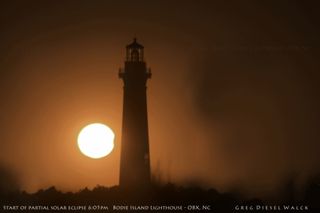
Walck also sent in a photo of the partial solar eclipse taken in the Outer Banks of North Carolina on Oct. 23, 2014.

Northwestern University graduate student James Hedrick sent in a photo of the partial solar eclipse taken in Evanston, Illinois, on Oct. 23, 2014.
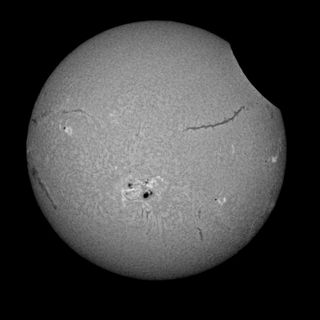
The partial solar eclipse of Oct. 23, 2014, approaches its conclusion at the Arizona location of the Mt. Lemmon SkyCenter.
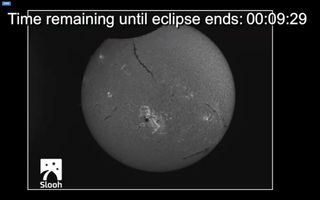
The Slooh online telescope shows the tail end of the partial solar eclipse on Oct. 23, 2014. The live webcast used an image from a telescope in Prescott, Arizona. Filaments and sunspots appear quite distinctly in this image.
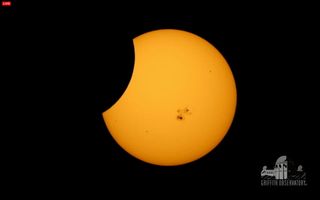
The moon has almost completely crossed the sun's disk nearing the end of the partial solar eclpse of Oct. 23, 2014, as shown in this image of the live webcast from Griffith Observatory in Los Angeles.
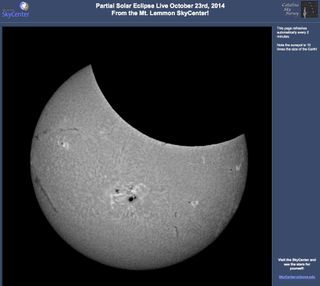
The moon continued to pass in front of the sun on Oct. 23, 2014, as shown in this live webcast image provided by the Mt. Lemmon SkyCenter, Arizona.
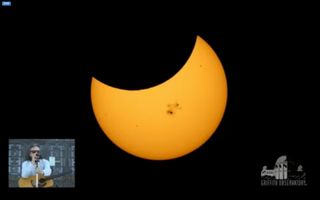
Griffith Observatory in Los Angeles brought out a special guest, singer-songwriter Donovan, to play and sing at the moment of maximum partial solar eclipse on Oct. 23, 2014. He played, appropriately, his song "Sunshine Superman."
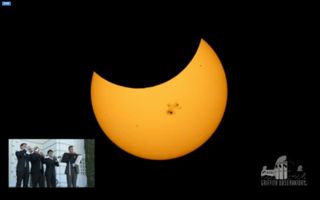
At Griffith Observatory, the USC Trumpet Quartet played a fanfare for the arrival of maximum eclipse at 6:27 PM EDT. They performed "Also Sprach Zarathustra" by Richard Strauss.
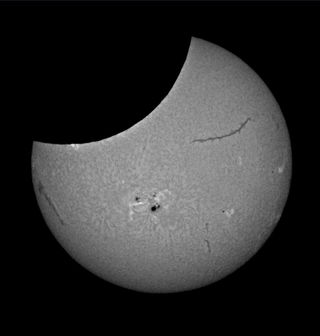
Mt. Lemmon SkyCenter lies about a 90-minute drive north of Tucson, Arizona. The facility live-streamed the partial solar eclipse on Oct. 23, 2014.

The Slooh Online Telescope, using a live feed from Prescott, Arizona, showed the progress of the moon as it partially blocked the sun on Oct. 23, 2014. They answered questions from viewers, as seen here.
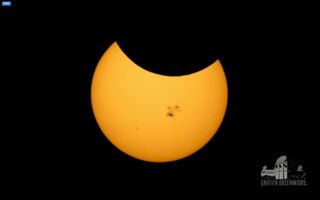
Griffith Observatory in Los Angeles, atop the Hollywood Hills, live-streamed the partial solar eclipse on Oct. 23, 2014. The Angelenos had clear skies with which to view the phenomenon.
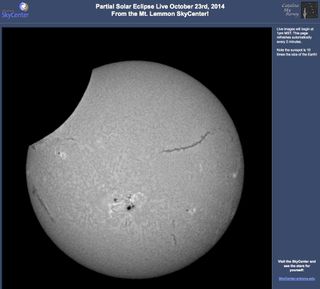
Another image from the Mt. Lemmon SkyCenter in Arizona, presented on their live webcast, shows the moon crossing the face of the sun on Oct. 23, 2014.
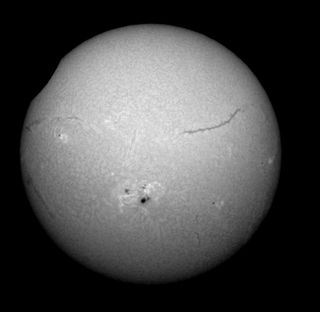
The partial solar eclipse of Oct. 23, 2014, begins, as seen by the Mt. Lemmon SkyCenter in Arizona, presented on their live webcast.
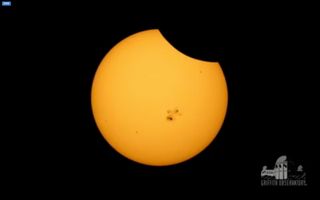
About 20 minutes into the partial solar eclipse, another image from the website of Griffith Observatory, Los Angeles, shows the moon encroaching more on the sun's disk.
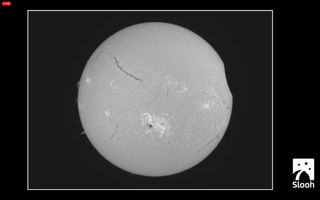
The partial solar eclipse of Oct. 23, 2014, begins, as seen by the Slooh online telescope, presented on their live webcast.
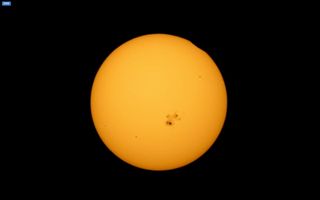
The partial solar eclipse of Oct. 23, 2014, just begins (at upper right of sun's disk), as seen at Griffith Observatory, Los Angeles, presented on their live webcast.
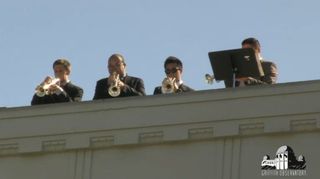
The partial solar eclipse of Oct. 23, 2014, was ushered in at Griffith Observatory, Los Angeles, with the playing of the Triumphal March from "Aida" by the USC Trumpet Quartet.
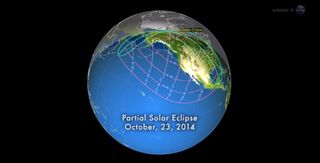
This NASA graphic shows the region of visibility for the partial solar eclipse of Oct. 23. NASA eclipse expert Fred Espenak created this view, which shows the track of the eclipse as the moon's shadow moves across the Earth's surface. Credit: NASA.
Follow us @Spacedotcom, Facebook and Google+.
Join our Space Forums to keep talking space on the latest missions, night sky and more! And if you have a news tip, correction or comment, let us know at: community@space.com.

Space.com is the premier source of space exploration, innovation and astronomy news, chronicling (and celebrating) humanity's ongoing expansion across the final frontier. Originally founded in 1999, Space.com is, and always has been, the passion of writers and editors who are space fans and also trained journalists. Our current news team consists of Editor-in-Chief Tariq Malik; Editor Hanneke Weitering, Senior Space Writer Mike Wall; Senior Writer Meghan Bartels; Senior Writer Chelsea Gohd, Senior Writer Tereza Pultarova and Staff Writer Alexander Cox, focusing on e-commerce. Senior Producer Steve Spaleta oversees our space videos, with Diana Whitcroft as our Social Media Editor.
Most Popular

